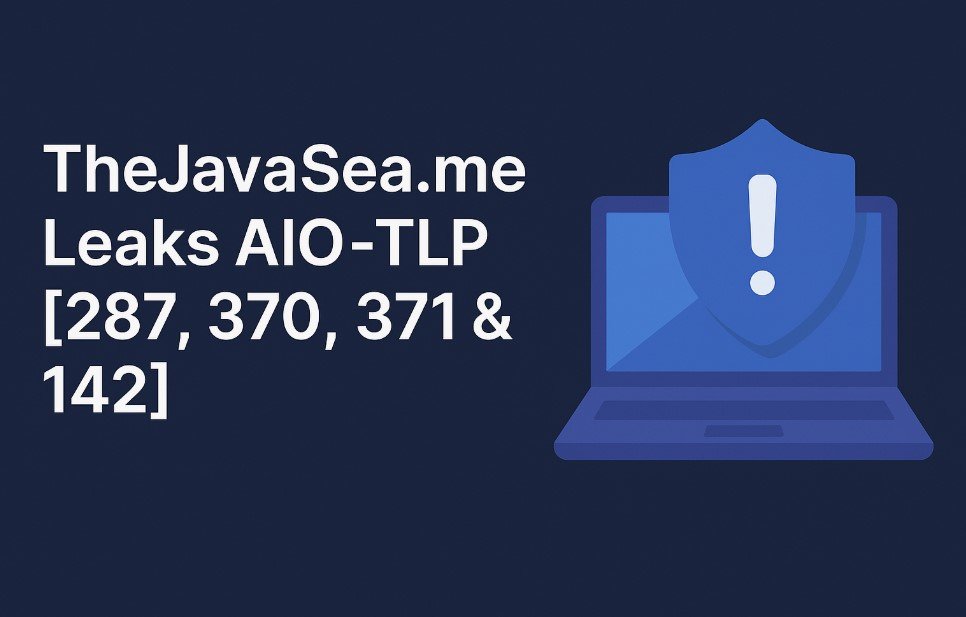Tech
TheJavaSea.me Leaks AIO‑TLP [287, 370, 371 & 142]

In recent months, a major data breach has emerged on the platform TheJavaSea.me. Several significant batches of data, identified by the labels 287, 370, 371 and 142, have appeared online. These files contain sensitive materials ranging from internal communications to personal credentials. The breach is being referred to as thejavasea.me leaks aio‑tlp, and it represents a serious threat to both individuals and businesses. In this article, we provide a complete and easy-to-follow summary of what was leaked, why it matters, and how people can protect themselves.
Understanding AIO‑TLP Data Leaks
The term AIO‑TLP stands for All-in-One Traffic Light Protocol. This protocol is a standard for classifying the sensitivity of information. In this system, data may be marked as TLP‑White, TLP‑Green, TLP‑Amber, or TLP‑Red. White data is public and safe to share. Green data is intended for internal use. Amber data should be shared on a limited basis. Red data is highly sensitive and should not be shared outside of a trusted circle. The fact that thejavasea.me leaks aio‑tlp contains Amber and Red data means this breach is particularly serious.
The most recent leaks labeled 287, 370, 371, and 142 combine files of different sensitivity levels. This suggests that whoever accessed the data had full access to archived material or internal files. Some of the leaked data comes from private servers, internal discussions, legal documents, and credential databases.
Leak Batch 287
Thejavasea.me leaks aio‑tlp287 includes a large set of internal communications, documents, and data. The documents appear to come from a small to mid-size technology company. There are executive emails, sales reports, financial statements, and internal memos. Some files reveal client lists, pricing models, and development plans.
Users should assume that if they were part of that company or had business dealings with the company, their names and contact information may be exposed. Emails and internal chats may reveal personal opinions or company strategies. The presence of financial spreadsheets raises the risk of reputational harm or legal implications for both employees and executives.
Leak Batches 370 and 371
Thejavasea.me leaks aio‑tlp370 and thejavasea.me leaks aio‑tlp371 appear to focus on a different set of organizations. These files include bid proposals, contracts, project specifications, and planning documents. Some documents are marked as confidential or for internal use only.
The source appears to be contractors working with government clients. The proposals include project budgets and timelines as well as internal review comments. These leaks are especially concerning from a security standpoint. They reveal project scope, risk assessments, and internal review processes – all of which could be useful to an attacker.
Leak Batch 142
Thejavasea.me leaks aio‑tlp142 is perhaps the most concerning. It contains highly sensitive personal data. It includes customer records, credential files, possible financial account data, and scanned identity documents. This is clearly Red data, and it poses serious risks.
If any of this personal data is tied to real people, they could become victims of identity theft, fraud, or phishing attacks. Exposed authentication tokens can be used to access private accounts. Stolen documents can lead to unauthorized account takeovers or financial fraud.
How the Data May Have Been Stolen
Based on the nature of the files and their sensitivity levels, it is likely the leaks came from one of these scenarios:
- A phishing attack that targeted employees
- Malware installed on internal systems
- Misconfigured or exposed server storage
- An insider leak
The data appears to come from multiple companies and sources. This suggests that access may have come through a shared development or backup server. Once one set of credentials was compromised, the attacker may have moved laterally across systems.
Why This Breach Matters
This data leak is a major incident for several reasons:
- It combines multiple batches of sensitive data from varied sectors.
- It includes Red data containing personal and financial information.
- It was released publicly, meaning unauthorized users have access to the data now.
A lot of the leaked information cannot be retracted. Even if the original provider removes the files, copies may persist online. Data removal is a challenge once it has been downloaded or shared.
Steps to Protect Yourself
If your data was included in the leak, or if you suspect it may have been, here are steps you can take:
- Change all passwords immediately and make sure each account has a unique, strong password.
- Enable multi-factor authentication on all services that allow it.
- Monitor accounts for suspicious activity. Check statements and logs regularly.
- Freeze or monitor credit reports if personal data was exposed.
- Use identity theft protection services that notify you of fraudulent activity.
- Alert your contacts to potential phishing attempts using your stolen email.
- Update your software on all devices to patch vulnerabilities.
- Regularly review account permissions. Remove unused or outdated accounts.
These measures do not guarantee safety, but they reduce the chances of data misuse.
How Organizations Should Respond
Companies affected by the leaks should take the following actions:
- Perform incident response – Identify impacted systems and data.
- Notify authorities and affected individuals – Transparency is key.
- Hire a cybersecurity firm – Experts can help with forensic analysis.
- Apply security patches and harden defenses across systems.
- Train employees with phishing simulations and best practices.
- Review internal audit logs for unusual activity.
- Reissue credentials or documents that were compromised.
- Schedule future security reviews to prevent breaches.
Legal and Regulatory Implications
In many jurisdictions, this leak may violate data privacy laws such as:
- GDPR in Europe requires notifying regulators within 72 hours.
- CCPA in California mandates breach disclosure to consumers.
- HIPAA if medical data were disclosed.
Failure to comply can result in penalties, fines, and long-term reputational damage.
The Role of Platforms in Preventing Leaks
Hosts like TheJavaSea.me make it easier for leaked data to spread. They rely on anonymity and decentralized hosting, which makes legal enforcement difficult. However, developers and policymakers should consider:
- Takedown requests to remove unauthorized content.
- Blocking or reporting sites that distribute sensitive data.
- Defining responsibilities for platforms that host leaks.
- Strengthening international cooperation to hold hosts accountable.
Legal and technical solutions must work together to prevent widespread data exposure.
Why Users Need to Take This Seriously
Once leaked, data cannot be fully recalled. Exposed information can be copied, altered, or weaponized. Phishers and scammers may use the data to craft targeted attacks. The longer the data remains accessible, the higher the potential impact.
It is not just companies at risk. Individuals face ongoing threats from identity theft and financial fraud. Personal information can be abused for credit card applications, login attempts, or deepfake generation.
Looking Ahead
The AIO‑TLP leaks on TheJavaSea.me highlight the need for better data protection and coordinated response efforts. Cybersecurity defenses must be proactive, not just reactive. Organizations should:
- Adopt zero trust principles – never assume internal traffic is safe.
- Use encryption at rest and in transit.
- Regularly audit third-party access to sensitive files.
- Ensure backups are secure and isolated.
- Educate employees on data security practices.
By taking these steps, organizations can reduce the chances of future leaks.
Conclusion
Thejavasea.me leaks aio‑tlp287, thejavasea.me leaks aio‑tlp370, thejavasea.me leaks aio‑tlp371, and thejavasea.me leaks aio‑tlp142 represent a serious breach of sensitive information. The leaks contain internal documents, credentials, personal identification, and financial data. The exposure of this information presents real risks. Individuals and organizations need to take immediate action. This includes changing passwords, enabling multi-factor authentication, monitoring financial activity, and strengthening cybersecurity measures. Regulatory bodies may impose heavy fines if response procedures are not followed. It is crucial to treat this leak as a warning and work to reduce future vulnerabilities.














